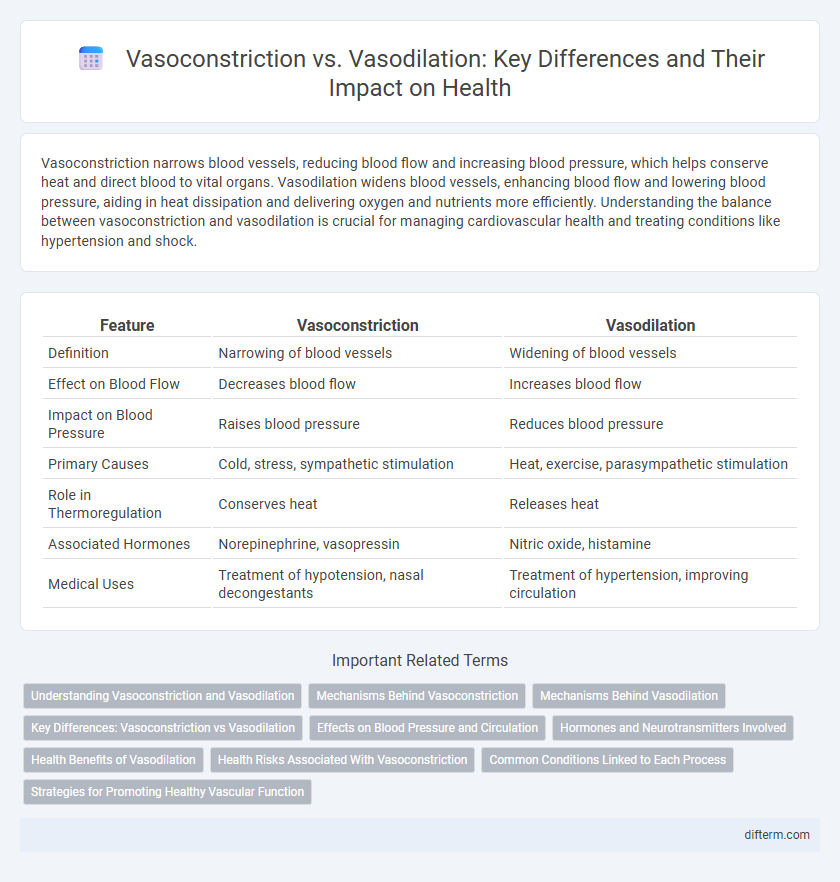Vasoconstriction narrows blood vessels, reducing blood flow and increasing blood pressure, which helps conserve heat and direct blood to vital organs. Vasodilation widens blood vessels, enhancing blood flow and lowering blood pressure, aiding in heat dissipation and delivering oxygen and nutrients more efficiently. Understanding the balance between vasoconstriction and vasodilation is crucial for managing cardiovascular health and treating conditions like hypertension and shock.
Table of Comparison
| Feature | Vasoconstriction | Vasodilation |
|---|---|---|
| Definition | Narrowing of blood vessels | Widening of blood vessels |
| Effect on Blood Flow | Decreases blood flow | Increases blood flow |
| Impact on Blood Pressure | Raises blood pressure | Reduces blood pressure |
| Primary Causes | Cold, stress, sympathetic stimulation | Heat, exercise, parasympathetic stimulation |
| Role in Thermoregulation | Conserves heat | Releases heat |
| Associated Hormones | Norepinephrine, vasopressin | Nitric oxide, histamine |
| Medical Uses | Treatment of hypotension, nasal decongestants | Treatment of hypertension, improving circulation |
Understanding Vasoconstriction and Vasodilation
Vasoconstriction involves the narrowing of blood vessels due to the contraction of muscular walls, primarily affecting arteries and arterioles, which increases blood pressure and reduces blood flow to specific areas. In contrast, vasodilation refers to the widening of blood vessels caused by the relaxation of smooth muscle cells, enhancing blood flow and decreasing vascular resistance. These processes play critical roles in regulating body temperature, blood pressure, and tissue perfusion, with imbalances potentially contributing to conditions like hypertension or ischemia.
Mechanisms Behind Vasoconstriction
Vasoconstriction occurs through the contraction of smooth muscle cells in the blood vessel walls, primarily regulated by the autonomic nervous system and signaling molecules such as norepinephrine and endothelin. Activation of alpha-adrenergic receptors triggers an increase in intracellular calcium levels, leading to muscle contraction and reduced vessel diameter. This mechanism plays a crucial role in regulating blood pressure and directing blood flow during stress or cold exposure.
Mechanisms Behind Vasodilation
Vasodilation involves the relaxation of smooth muscle cells in blood vessel walls, primarily triggered by the release of nitric oxide (NO) from endothelial cells, which activates guanylate cyclase and increases cyclic GMP levels. This biochemical cascade leads to decreased intracellular calcium concentrations, resulting in smooth muscle relaxation and vessel widening. Other key mediators of vasodilation include prostacyclin and endothelium-derived hyperpolarizing factors, which contribute to the regulation of vascular tone and blood flow.
Key Differences: Vasoconstriction vs Vasodilation
Vasoconstriction refers to the narrowing of blood vessels caused by the contraction of muscular walls, leading to reduced blood flow and increased blood pressure, whereas vasodilation involves the widening of blood vessels resulting from the relaxation of these muscles, which enhances blood flow and decreases blood pressure. Vasoconstriction typically occurs in response to cold temperatures or stress to conserve heat and maintain blood pressure, while vasodilation happens during heat exposure or physical activity to dissipate heat and improve oxygen delivery to tissues. Understanding these mechanisms is crucial in managing conditions like hypertension, shock, and ischemia through targeted therapies.
Effects on Blood Pressure and Circulation
Vasoconstriction narrows blood vessels, increasing vascular resistance and raising blood pressure, which can reduce blood flow to peripheral tissues. Vasodilation widens blood vessels, decreasing resistance and lowering blood pressure, thereby enhancing circulation and oxygen delivery to organs. These mechanisms play critical roles in regulating cardiovascular function and maintaining homeostasis during changes in physical activity or stress.
Hormones and Neurotransmitters Involved
Hormones such as norepinephrine and epinephrine trigger vasoconstriction by binding to alpha-adrenergic receptors on blood vessels, leading to vessel narrowing and increased blood pressure. In contrast, vasodilation is promoted by nitric oxide and acetylcholine, which relax vascular smooth muscle and improve blood flow. The balance between vasoconstrictive neurotransmitters and vasodilatory agents regulates critical physiological functions like tissue perfusion and blood pressure homeostasis.
Health Benefits of Vasodilation
Vasodilation improves blood flow by relaxing the inner muscles of blood vessels, which helps lower blood pressure and reduces the risk of cardiovascular diseases such as hypertension and heart attacks. Enhanced oxygen and nutrient delivery to tissues through vasodilation supports faster healing and better overall organ function. This natural process also aids in temperature regulation and can relieve symptoms related to poor circulation, such as cold extremities and headaches.
Health Risks Associated With Vasoconstriction
Vasoconstriction, the narrowing of blood vessels, significantly increases the risk of hypertension by raising blood pressure and reducing blood flow to vital organs. Prolonged vasoconstriction can lead to ischemia, causing tissue damage and increasing the likelihood of heart attacks or strokes due to restricted oxygen supply. This condition also exacerbates peripheral artery disease and contributes to complications in individuals with diabetes or chronic kidney disease.
Common Conditions Linked to Each Process
Vasoconstriction is commonly linked to conditions such as hypertension and Raynaud's disease, where narrowed blood vessels reduce blood flow and increase blood pressure. Vasodilation, on the other hand, is associated with inflammatory diseases and septic shock, characterized by the widening of blood vessels that can lead to hypotension and increased tissue perfusion. Understanding the balance between these vascular responses is crucial in managing cardiovascular health and systemic circulation disorders.
Strategies for Promoting Healthy Vascular Function
Maintaining healthy vascular function involves strategies that balance vasoconstriction and vasodilation through lifestyle and dietary choices. Regular physical activity enhances endothelial function and nitric oxide production, promoting vasodilation and improved blood flow. Incorporating foods rich in antioxidants, omega-3 fatty acids, and potassium supports vascular elasticity while managing stress levels helps prevent excessive vasoconstriction linked to hypertension.
Vasoconstriction vs Vasodilation Infographic

 difterm.com
difterm.com